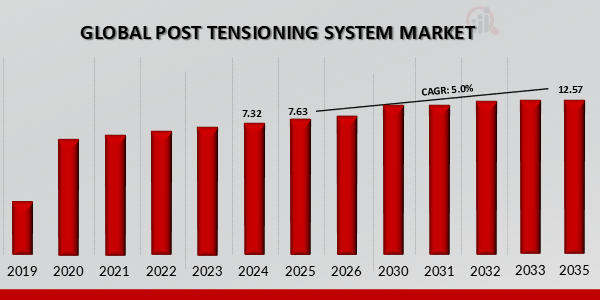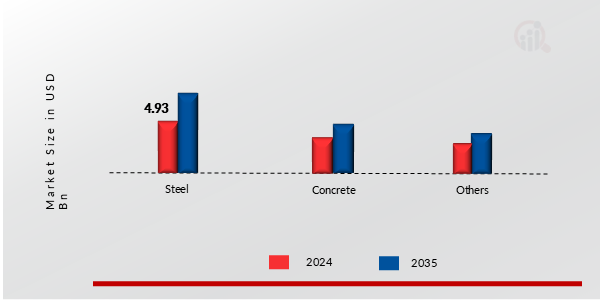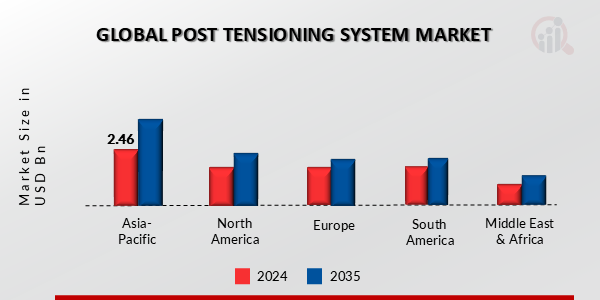Global Post Tensioning System Market Overview
The Post Tensioning System Market size was valued at USD 7.32 Billion in 2024. The Post Tensioning System Market industry is projected to grow from USD 7.62 Billion in 2025 to USD 12.57 Billion by 2035, exhibiting a compound annual growth rate (CAGR) of 5.0% during the forecast period (2025-2035).
The increasing infrastructure development and rising demand for high-strength construction materials and technological advancements in post tensioning systems and growth of the construction industry in emerging markets and government Initiatives and investments in infrastructure are driving the growth of the Post Tensioning System Market.
As per the Analyst at MRFR, as urban populations increase globally, there is a rising need for infrastructure such as roads, bridges, tunnels, and commercial buildings. Post-tensioning systems provide the necessary strength and durability to support such large-scale infrastructure projects. As cities expand and the need for complex infrastructure grows, the demand for post-tensioning systems increases to ensure the safety and longevity of critical structures.
Many government and private sector projects, such as highways, bridges, and high-rise buildings, benefit from the use of post-tensioning due to its ability to reduce the overall weight of the concrete and provide greater load-bearing capacity.
This is especially important for infrastructure that needs to withstand high traffic volumes, seismic activity, and harsh weather conditions. In developed regions, many infrastructure elements such as bridges, tunnels, and highways are aging and need to be either rehabilitated or replaced. Post-tensioning systems are widely used in these restoration projects to extend the lifespan and improve the load-bearing capacity of existing infrastructure. Post-tensioning is increasingly being used for construction in regions prone to earthquakes, floods, or heavy snow. These systems enhance the structural resilience of buildings, ensuring that infrastructure can withstand such challenges, driving further in the infrastructure sector.
FIGURE 1: POST TENSIONING SYSTEM MARKET VALUE (2019-2035) USD BILLION

Source: Secondary Research, Primary Research, MRFR Database, and Analyst Review
Post Tensioning System Market Opportunity
-
INCREASED ADOPTION OF SMART BUILDINGS
As the construction industry increasingly embraces smart buildings—structures equipped with IoT (Internet of Things) sensors, automation systems, and energy-efficient technologies—post-tensioning systems can play a critical role. These systems enhance the structural integrity of buildings while complementing smart technologies such as real-time monitoring of stress, temperature, and other key parameters through sensors embedded in the structure. This allows building managers to monitor the health of the building in real-time and perform preventive maintenance, ultimately enhancing the building’s longevity and safety.
Smart buildings often require high-performance construction materials to ensure both resilience and sustainability. Post-tensioning systems, with their ability to improve concrete’s tensile strength and durability, make them an ideal choice for buildings that need to support advanced systems and technologies.
As more smart cities are developed globally, there will be greater demand for advanced construction techniques like post-tensioning to support the infrastructure. In smart buildings, the focus is often on energy efficiency, optimal space usage, and structural optimization. Post-tension systems contribute to this by allowing for slimmer and lighter structures, which can help optimize space and reduce energy consumption. This makes post-tensioning a valuable technology for the growing smart building sector.
Post Tensioning System Market Segment Insights
Post Tensioning System by System Type Insights
Based on System Type, this segment includes Bonded Post Tensioning System and Unbonded Post tensioning System. The Bonded Post Tensioning System segment dominated the global market in 2024, while the Unbonded Post Tensioning System is projected to be the fastest–growing segment during the forecast period. The bonded post tensioning system is a vital segment of the post-tensioning market, widely adopted for its structural durability and cost-efficiency. This system involves the use of tendons encased in ducts and filled with grout after tensioning, creating a permanent bond between the concrete and the steel.
Such a mechanism enhances load-carrying capacity and reduces structural deflection, making it a preferred choice in large-scale infrastructure projects like bridges, tunnels, and elevated roadways. Its popularity stems from superior crack control and corrosion resistance, ensuring long-term structural integrity, particularly in aggressive environmental conditions. Additionally, bonded systems allow for efficient load distribution and are highly customizable to meet diverse engineering needs.
Growing urbanization and increasing investments in infrastructure development across regions are driving demand for bonded post-tensioning systems. With advancements in construction technology and a rising emphasis on sustainable practices, this system is expected to witness robust adoption in both developed and emerging markets.
Post Tensioning System by Material Insights
Based on Material, this segment includes Steel, Concrete, Others. The Steel segment dominated the global market in 2024, while the Concrete segment is projected to be the fastest–growing segment during the forecast period. The steel segment dominates the post tensioning system market due to its superior strength, durability, and ability to withstand high stress, making it the preferred choice for various construction projects. Steel tendons, typically in the form of strands or bars, are widely used in post tensioning systems for applications such as bridges, high-rise buildings, and parking structures.
Steel's resistance to tension ensures the structural integrity of concrete by providing the necessary reinforcement to handle dynamic loads and environmental stresses. Furthermore, steel’s high tensile strength allows for thinner and more efficient concrete designs, reducing material costs. Additionally, advancements in steel coating technologies, like galvanization, have enhanced the material's corrosion resistance, further increased its longevity and reduced maintenance needs. As construction projects demand more durable and cost-effective solutions, steel remains the go to material, propelling growth in the post tensioning system market across infrastructure and commercial building sectors.
FIGURE 2: POST TENSIONING SYSTEM MARKET SHARE BY MATERIAL 2024 AND 2035 (USD BILLION)

Source: Secondary Research, Primary Research, Market Research Future Database and Analyst Review
Post Tensioning System by Product Insights
Based on Product, this segment includes Tendons, Anchoring Systems, Ducts, Grouting Materials, Others. The Tendons segment dominated the global market in 2024, while the Anchoring Systems segment is projected to be the fastest–growing segment during the forecast period. The tendons segment holds a pivotal role in the post tensioning system market because of its widespread application in various infrastructure and building projects. Tendons, comprising steel cables or bars encased in ducts, are instrumental in enhancing the structural integrity and load-bearing capacity of concrete.
This product type is extensively used in bridges, commercial buildings, and high-rise structures to counter tensile forces and prevent cracking. The rising demand for durable and cost-effective construction solutions has propelled the adoption of tendons in both new constructions and retrofitting projects. Additionally, innovations in materials, such as advanced steel alloys and corrosion-resistant coatings, are improving the longevity and performance of tendons, further fueling market growth. With increasing urbanization and the expansion of critical infrastructure in emerging economies, the tendons segment is poised for significant expansion.
Market players are focusing on precision-engineered solutions to meet specific project requirements, ensuring their dominance in this high demand segment.
Post Tensioning System by Application Insights
Based on Application, this segment includes Buildings (Commercial Buildings and Residential Buildings), Infrastructure (Bridges Flyovers, Dams, Tunnels, Others), Energy (Power Plants, Wind Towers, Others), Others. The Buildings segment dominated the global market in 2024, while the infrastructure (Bridges Flyovers) segment is projected to be the fastest–growing segment during the forecast period. The use of post tensioning systems in buildings has gained significant traction due to their ability to optimize structural performance and enhance architectural flexibility. These systems allow for thinner slabs, longer spans, and fewer columns, making them ideal for commercial buildings, residential complexes, and high-rise structures.
By reducing material requirements and increasing load-carrying capacity, post tensioning contributes to cost effective and sustainable construction. Post tensioning also enhances resistance to cracking and seismic forces, improving the durability and safety of structures. The growing focus on urbanization, infrastructure modernization, and the demand for space efficient designs have further driven the adoption of these systems. Key advancements, such as corrosion resistant tendons and advanced anchorage systems, have boosted their application in challenging environments, ensuring long term performance.
Additionally, the integration of post tensioning with building information modeling has streamlined design and construction processes, offering precise implementation and improved project timelines.
Post Tensioning System by End-Use Insights
Based on End-Use, this segment includes New Construction and Repair Rehabilitation. The New Construction segment dominated the global market in 2024, while the Repair Rehabilitation segment is projected to be the fastest–growing segment during the forecast period. The new construction segment of the post tensioning system market is experiencing significant growth due to the rising demand for durable, cost-effective, and high-performance building solutions. Post tensioning is increasingly being utilized in the construction of bridges, high-rise buildings, parking structures, and commercial complexes.
This method enhances the structural integrity and load-bearing capacity of concrete, making it ideal for large-scale projects that require flexibility, speed, and reduced material usage. The growing trend towards urbanization, coupled with the need for innovative construction techniques, is driving the adoption of post tensioning systems in new buildings.
Additionally, post tensioning offers the advantage of reducing the overall weight of structures while maintaining high strength, resulting in lower foundation costs and faster construction timelines. As architects and engineers continue to prioritize sustainability and efficient construction practices, post tensioning systems will play a crucial role in meeting the demands of modern construction projects across both developed and emerging markets.
Post Tensioning System Regional Insights
Based on the Region, the global Post Tensioning System is segmented into North America, Europe, Asia-Pacific, Middle East & Africa, South America. Major demand factors driving the Asia-Pacific market are the increasing infrastructure development and rising demand for high-strength construction materials and technological advancements in post tensioning systems and growth of the construction industry in emerging markets and government Initiatives and investments in infrastructure. The Asia Pacific region represents a significant market for post-tensioning systems, driven by robust infrastructure development and rapid urbanization.
Countries such as China, India, and Southeast Asian nations are investing heavily in modernizing transportation networks, commercial spaces, and residential complexes.
For instance, in India, post tensioning was employed in the Bandra-Worli Sea Link project in Mumbai, enabling the iconic bridge to withstand high traffic loads and extreme environmental conditions. Similarly, China has utilized post tensioning in its expansive high-speed rail network to ensure the durability and stability of viaducts and bridges. In the building sector, post tensioning is increasingly used in high-rise construction to reduce concrete volume and improve structural efficiency. Technology also plays a vital role in Asia Pacific's growing focus on green building practices, as it reduces material wastage and carbon footprints.
For example, post tensioning systems were incorporated into the Marina Bay Sands in Singapore, allowing for innovative architectural designs while maintaining structural integrity.
Governments and private stakeholders are also channeling investments into infrastructure rehabilitation, where post tensioning systems are vital for strengthening aging structures. Initiatives such as China's Belt and Road and India’s Smart Cities Mission further fuel demand. With a combination of large-scale infrastructure projects and an increasing focus on sustainable construction, the Asia Pacific region is poised to witness substantial growth in the post tensioning system market.
FIGURE 3: POST TENSIONING SYSTEM MARKET VALUE BY REGION 2024 AND 2035 (USD BILLION)

Source: Secondary Research, Primary Research, Market Research Future Database, and Analyst Review
Further, the countries considered in the scope of the Application Tracking System Market are the US, Canada, Mexico, Germany, the UK, France, Russia, Italy, Spain, China, India, Japan, South Korea, Malaysia, Thailand, Indonesia, Brazil, Argentina, GCC Countries, South Africa and others.
Global Post Tensioning System Key Market Players & Competitive Insights
Many global, regional, and local vendors characterize the Post Tensioning System Market. The market is highly competitive, with all the players competing to gain market share. Intense competition, rapid advances in technology, frequent changes in government policies, and environmental regulations are key factors that confront market growth. The vendors compete based on cost, product quality, reliability, and government regulations. Vendors must provide cost-efficient, high-quality products to survive and succeed in an intensely competitive market.
The major players in the market are Freyssine, DYWIDAG, SRG Global, VSL Internation Ltd., Liuzhou OVM Machinery Co., Ltd., Interspan Group, CMC (Commercial Metals Company), Post Tensioning Solutions LLC, Tensacciai S.r.l. are among others. The Post Tensioning System Market is a consolidated market due to increasing competition, acquisitions, mergers and other strategic market developments and decisions to improve operational effectiveness.
Key Companies in the Post Tensioning System Market include
- Freyssine
- DYWIDAG
- SRG Global
- VSL Internation Ltd.
- Liuzhou OVM Machinery Co., Ltd.
- Interspan Group
- CMC (Commercial Metals Company)
- Post Tensioning Solutions LLC
- Tensacciai S.r.l.
Post Tensioning System Market Industry Developments
June 2023: Fressinet announced that it has made progress on West Gate Tunnel infrastructure project in Melbourne, Australia. According to this, the company installed post-tensioning for the viaduct piers and spans, the setting up of precast columns and the erection of segmental spans utilizing a bespoke launching girder.
September 2021: DYWIDAG acquired a Finland-based specialty construction and engineering company, Tensicon Oy. According to the company, the acquisition will increase and broaden DYWIDAG’s geotechnical and post-tensioning portfolio in the Nordic markets and provides the opportunity to implement DYWIDAG’s digital strategy in Scandinavia.
December 2022: SRG Global announced that it has acquired Bartek, that helps the company expand the current product range of SRG Global’s Engineered Products business.
March 2023: Commercial Metals Co. announced that it has acquired Tendon Systems LLC, Suwanee, Georgia-based barrier cable, post-tensioning, and concrete restoration systems provider.
Post Tensioning System Market Segmentation
Post Tensioning System by System Type Outlook
- Bonded Post Tensioning System
- Unbonded Post Tensioning System
Post Tensioning System by Material Outlook
Post Tensioning System by Product Outlook
- Tendons
- Anchoring Systems
- Ducts
- Grouting Materials
- Others
Post Tensioning System by Application Outlook
-
Buildings
- Commercial Buildings
- Residential Buildings
-
Infrastructure
- Bridges Flyovers
- Dams
- Tunnels
- Others
-
Energy
- Power Plants
- Wind Towers
- Others
- Others
Post Tensioning System by End-Use Outlook
- New Construction
- Repair Rehabilitation
Post Tensioning System Regional Outlook
-
North America
-
Europe
- Germany
- UK
- France
- Russia
- Italy
- Spain
- Rest of Europe
-
Asia-Pacific
- China
- India
- Japan
- South Korea
- Malaysia
- Thailand
- Indonesia
- Rest of Asia-Pacific
-
South America
- Brazil
- Mexico
- Argentina
- Rest of South America
-
Middle East & Africa
- GCC Countries
- South Africa
- Rest of Middle East & Africa
|
Report Attribute/Metric
|
Details
|
|
Market Size 2024
|
USD 7.32 Billion
|
|
Market Size 2025
|
USD 7.62 Billion
|
|
Market Size 2035
|
USD 12.57 Billion
|
|
Compound Annual Growth Rate (CAGR)
|
5.0% (2025-2035)
|
|
Base Year
|
2024
|
|
Forecast Period
|
2025-2035
|
|
Historical Data
|
2019-2023
|
|
Forecast Units
|
Value (USD Billion)
|
|
Report Coverage
|
Revenue Forecast, Competitive Landscape, Growth Factors, and Trends
|
|
Segments Covered
|
By System Type, By Material, By Product, By Application, By End-Use
|
|
Geographies Covered
|
North America, Europe, Asia Pacific, Middle East & Africa, South America
|
|
Countries Covered
|
The US, Canada, Mexico, Germany, the UK, France, Russia, Italy, Spain, China, India, Japan, South Korea, Malaysia, Thailand, Indonesia, Brazil, Argentina, GCC Countries, South Africa
|
|
Key Companies Profiled
|
Freyssine, DYWIDAG, SRG Global, VSL Internation Ltd., Liuzhou OVM Machinery Co., Ltd., Interspan Group, CMC (Commercial Metals Company), Post Tensioning Solutions LLC, Tensacciai S.r.l.
|
|
Key Market Opportunities
|
· Increased Adoption of Smart Buildings
· Emergence of Sustainable Construction Practices
· Expansion of Renewable Energy Infrastructure
· Integration of Automation in Construction Processes
· Growing Urbanization and Population Density
|
|
Key Market Dynamics
|
· Increasing Infrastructure Development
· Rising Demand for High-Strength Construction Materials
· Technological Advancements in Post Tensioning Systems
· Growth of the Construction Industry in Emerging Markets
· Government Initiatives and Investments in Infrastructure
|
Frequently Asked Questions (FAQ):
USD 7.32 Billion is the Post Tensioning System Market in 2024
The Steel segment by Material holds the largest market share and grows at a CAGR of 4.7% during the forecast period.
Asia-Pacific holds the largest market share in the Post Tensioning System Market.
Freyssine, DYWIDAG, SRG Global, VSL Internation Ltd., Liuzhou OVM Machinery Co., Ltd., Interspan Group, CMC (Commercial Metals Company), Post Tensioning Solutions LLC, Tensacciai S.r.l. are the prominent players in the Post Tensioning System Market.
The Tendons segment dominated the market in 2024.

















